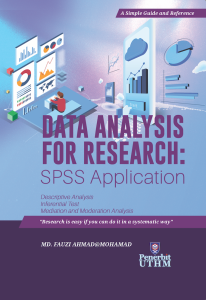Data Analysis For Research : SPSS Application
Keywords:
Data Analysis , Research , SPSS Application, statistical analysisSynopsis
At last, I manage to complete writing this book. Thanks to God for giving me, patience and inspiration. From my observation, many students and researchers still do not understand statistical analysis completely and this has been identified as a major problem in doing research or project. The main objective of this book is to provide step by step guidance in statistical analysis. It starts from explanation on type of statistical analysis, steps, results, interpretation and reporting. I believe that this book will improve statistical analysis understanding amongst students and researchers. This book contains thirteen chapters. In each chapter, examples of the statistical analysis are provided for better understanding using SPSS version 19. Furthermore, the interpretations of statistical result are explained in details for each of the examples. Hopefully this book will be useful to student for improving their understanding in statistical analysis. At last, thanks to UTHM for giving me the opportunity to publish this book.
Downloads
References
Brown, R. L. (1994). Efficacy of the indirect approach for estimating structural equation models with missing data: A comparison of five
methods. Structural Equation Modelling, 1(4), 287-316.
Byrne, B. . (2010). Structural Equation Modeling with AMOS. Structural Equation Modeling (2nd ed.). New York: Routledge Francis & Taylor.
Chi, A., Bahjat, A., & Matsui, Y. (2011). Quality management practices and competitive performance : Empirical evidence from Japanese
manufacturing companies. Intern. Journal of Production Economics, 133(2), 518-529. Elsevier. doi:10.1016/j.ijpe.2011.01.024
Chinna, K. (2009). Structural Equation Modeling Using AMOS (p. 20). Kuala Lumpur: Malaysia: Lecture Note for SPSS User’ Group.
Demirbag, M., Tatoglu, E., Tekinkus, M., & Zaim, S. (2006). An analysis of the relationship between TQM implementation and organizational performance: Evidence from Turkish SMEs. Journal of Manufacturing Technology Management, 17(6), 829-847. doi:10.1108/17410380610678828
Field, A. (2009). Discovering Statistics Using SPSS. Statistics (2nd ed.). London: Sage Publication.
Galbreath, J. (2005). Which resources matter the most to firm success? An exploratory study of resource-based theory. Technovation, 25(9), 979-987. doi:10.1016/j.technovation.2004.02.008
Graham, J. W., Hofer, S. M., Donaldson, S. L., MacKinnon, D. P., & Schafer, J. L. (1997). The Science of Prevention: Methodological advances from alcohol and substance abuse research (pp. 325-366). Washington, DC: American Psychological Association.
Gunday, G., Ulusoy, G., Kilic, K., & Alpkan, L. (2011). Effects of innovation types on firm performance. International Journal of Production Economics, 133(2), 662-676. Elsevier. doi:10.1016/j.ijpe.2011.05.014.
Hair, J. F. (2010a). Multivariate Data Analysis. New York: Pearson Prentice Hall.
Hair, J. F. (2010b). Multivariate Data Analysis. New Jersey: Englewood Cliffs.
Kline, R. . (2011). Principles and practices of structural equation modeling (3rd ed.). New York: The Guilford Press.
Krejcie, R. V., & Morgan, D. W. (1970). Determining sample size for research activities. Educ Psychol Meas.
Nunally, J. C. (1978). Psychometric Theory (Second ed.). New York: McGRAW-HILL.
Nunnally, J. C., & Bernstein, I. H. (1994). Psychometric Theory (3rd editio.). New York: McGRAW-HILL.
Rohani, J. M., Yusof, S. M., & Mohamad, I. (2009). The relationship between statistical process control critical success factors and performance: A structural equation modeling approach. 2009 IEEE International Conference on Industrial Engineering and Engineering Management, 1352-1356. Ieee. doi:10.1109/IEEM.2009.5373033
Sekaran, U., & Bougie, R. (2010). Research methods for business: a skill building approach. UK: Wiley.




